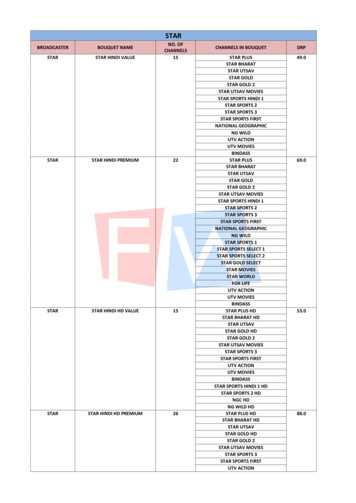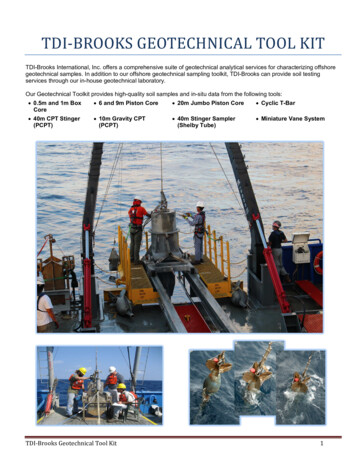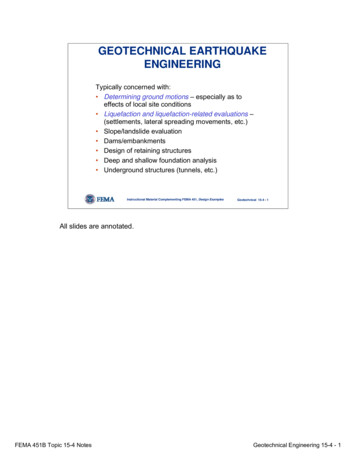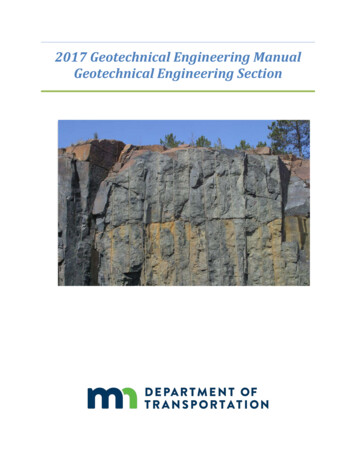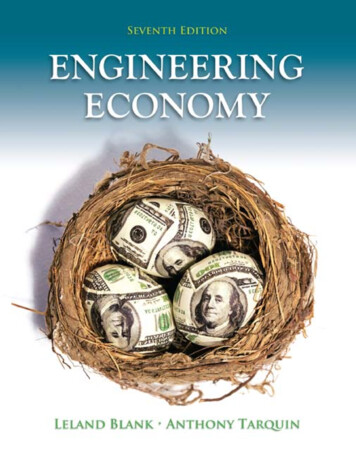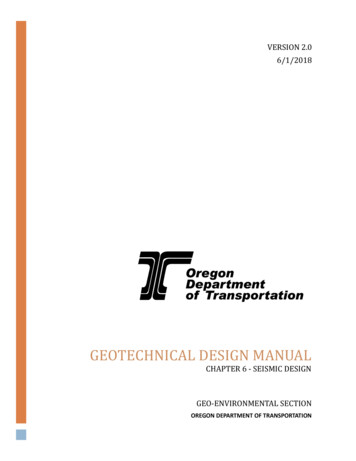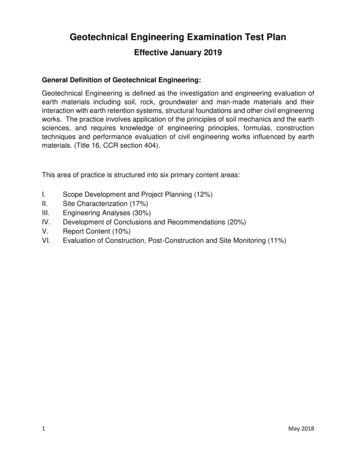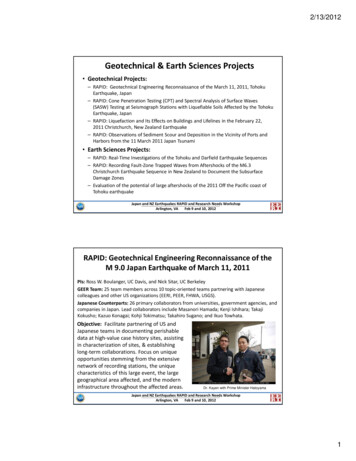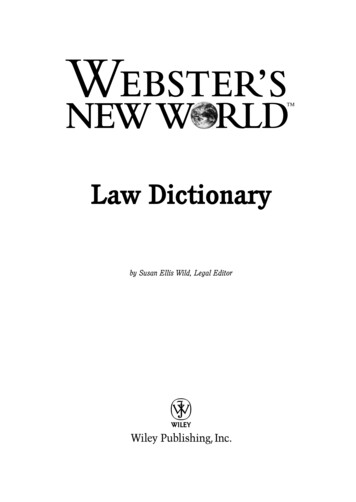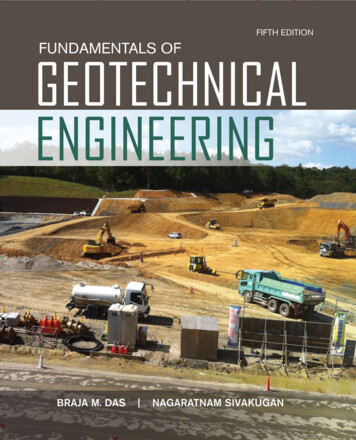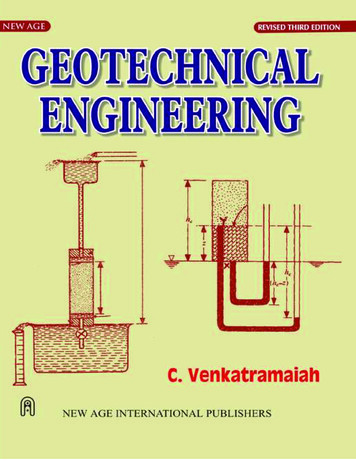
Transcription
GEOTECHNICALENGINEERING
THIS PAGE ISBLANK
Copyright 2006, 1995, 1993 New Age International (P) Ltd., PublishersPublished by New Age International (P) Ltd., PublishersAll rights reserved.No part of this ebook may be reproduced in any form, by photostat, microfilm,xerography, or any other means, or incorporated into any information retrievalsystem, electronic or mechanical, without the written permission of the publisher.All inquiries should be emailed to rights@newagepublishers.comISBN (10) : 81-224-2338-8ISBN (13) : 978-81-224-2338-9PUBLISHING FOR ONE WORLDNEW AGE INTERNATIONAL (P) LIMITED, PUBLISHERS4835/24, Ansari Road, Daryaganj, New Delhi - 110002Visit us at www.newagepublishers.com
Dedicated to the memory ofMy Parenu-in-lSmt. Ramalakshmi&Dr. A. Venkat& Subba Baofor ,1Mb- ' - and o/Yeetio,.lo". andaU 1M meMbue ofmy (Gmjly.
THIS PAGE ISBLANK
PREFACE TOTHE 1'Hnm EDITIONWith the enthusiastic response to the Second Edition of "GEOTECHNICAL ENGINEERING"from the academic community. the author has undertaken the task of preparing the ThirdEdition .The important features of this Edition are minor revision/additions in Chapters 7. 8, 10,17 and 18 and change over of the Illustrative Examples and Praclice Problems originally left inthe MKS units into the S.I . units so that the book is completely in the S.I. units. This is becausethe so-caned "Period of Transition" may be considered to have been over.The topics involving minor revision/addition in the respective chapters specificaUy are :Chapter 7Chapter 8Estimation of the settlement due to secondary compression.Uses and appli.cations of Skempton'g pore pressure parameters, and"Stress-path" approach and its usefulness.Chapter 10Chapter 17Unifonn load on an annular area (Ring foundation).Reinforced Earth and Geos ynthetics, and their applications ingeotechnical practice.Chapter 18The art of preparing a soil investigation report.Only brief and elementary treatment of the above has been given .Consequential changes at the appropriate places in the text, contents, answers to numerical problems, section numbers, figure numbers, chapter-wise references, and the indiceshave also been made .A few printing errors noticed in the previous edition have been rectified . The reader isrequested to refer to the latest revised versions of the 1.8. Codes mentioned in the book.In view of all these, it is hoped that the bouk would prove even more useful to the students than the previous edition .The author wishes to thank the geotechnical enbrineenng fraternity for the excellentsupport given to his book.Finally, the author thanks the Publishers for bringing out this Edition in a relativelyshort time, while impro.v ing the quality of production.C. VenkatramaiahTirupatiIndiaVii
THIS PAGE ISBLANK
PREFACE TOTHEFIRSTEnmONThe author does not intend to be apologetic for adding yet another book to the existing list inthe field of Geotechnical Engineering. For onc thing, the number of books avaiiable cannot beconsidered too large, although certain excellent reference books by Stalwarts in the field areavailable. For another, the number of books by Indian Authors is only a few. Specifically speak.ing, the number of books in this field in the S.I. System of Units is small, and books from Indianauthors are virtually negligible. This fact, coupled with the author's observation that not manybooks are available designed specifically to meet the requirements of undergraduate curnculum in Civil Engineering and Technology, has been the motivation to undertake this venture.The special features of this book are as follows:1. The S.L System of Units is adopted along with the equivalents in the M.K.S. Units insome instances. (A note on the S.l. Units commonly used in Geotechnical Engineering is included).2. Reference is made to the relevant Indian Standards·, wherever applicable, and extracts from these are quoted for the benefit of the student as well a8 the practisingengineer.3. A 'few illustrative problems and problems for practice are given in the M.K.S. Unitsto facilitate those who continue to use these Units during the transition period .4. The number of illustrative problems is fairly large compared to that in other books.This aspect would be helpful to the student to appreciate the various types of problems likely to be encountered.5. The number of problems for practice at the end of each chapter is also fairly large.The answers to the numerical Froblems are given at the end of the book.6. The illustrative examples and problems are graded carefully with regard to thetoughness.7. A few objective questions are also included at the end. This feature would be usefulto students even during their preparation for competitive and other examinationssuch as GATE .B. "Summary of Main Points", given at the e nd of each Chapter, would be vcr)' helpfulto a student trying to brush up his preparatiun on the eve of the examination.9. Chapter-wise references are given; this is CODl,!idered a better way to encourage further reading than a big Bibliography at the end . Note: References are invited to the latest editions ofthesc specifications for further details. Thesestandards are available from India n Standards Institution, New Delhi and it.s Regional Branch and Inepection Offices at Ahmedabad, Bangalorc. Bhopal. llhubaneshwar. Bombay, Calcutta. Chandigarh,Hyderabad, Jaipur. Kanpur, Madras, Patnn. Pune and Tri vilndrum.ix
xPREFACE10. The sequence of topics and subtopics is sought to made as logical as possible.Symbols and Nomenclature adopted are such that they are consistent (without significant variation from Chapter to Chapter), while being in close agreement with theintemational1y standardized ones . This would go a long way in minimising the possible confusion in the mind of the student.11. The various theories, formulae, and schools of thought are given in the most logicalsequence, laying greater emphasis on those that are most commonly used, or aremore sound from a scientific point of view.12. The author does not pretend to claim any originality for the material; however, hedoes claim some degree of special effort in the style of presentation, in the degree oflucidity sought to be imparted, and in his efforts to combine the good features ofprevious books in the field . An sources are properly acknowledged.The book has been designed as a Text-book to meet the needs of undergraduate curriculaofIndian Universities in the two conventional courses-"Soil Mechanics" and "Foundation Engineering" . Since a text always includes a little more than what is required, a few topics markedby asterisks may be omitted on first reading or by undergraduates depending on the needs oraspecific syllabus.The author wishes to express his grateful thanks and acknowledgements to:(i) The Indian Standards 1nstitution, for according permission to include extracts from anumber of relevant Indian Standard Codes of Practice in the field of Geotechnical Engineering ;(it) The authors and publishers ofvariou8 Technical papers and books, referred to in theappropriate places; and.(iti) The Sri Venkateswara University, for permission to include questions and problemsfrom their University Question Papers in the subject (some cases, in a modified system of Unite).The author specially acknowledges his colleague, Prof. K. Venkata Ramana, for criticallygoing through most of the Manuscript and offering valuable suggestions for improvement.Efforts wil1 be made to rectify errors, if any, pointed out by readers, to whom the authorwould be grateful. Suggestions for improvement are also welcome.The author thanks the publishers for bringing out the book nicely.The author places on record the invaluable RUpport and unstinted encoUragement received from his wife, Mrs. Lakshmi Suseela, and his daughters, Ms . Sarada and Ms. UshaPadmini, during the period of preparation of the manuscript.C. VenkatramaiahTirupatiIndia
PuRPoSE AND ScOPE OFTHEBOOK'GEOTECHNICAL ENGINEERING'There are not many books which cover both soil mechanics and foundation engineering which astudent can use for his paper on Geotechnical Engineering. This paper is studied compulsorilyand available books, whatever few are there, have not been found satisfactory. Students arecompelled to refer to three or four books to m eet their requirements. The author has beenprompted by the lack of a good comprehensive textbook to write this present work. He hasmade a sincere effort to sum up his experience of thirty three years of teaching in the presentbook. The notable features of the book are as follows:1. The S.1. (Standard International) System of Units, which is a modification of theMetric System of units, is adopted. A note on the S.l. Units is included by way ofelucidation.The reader is requested to refer to the latest revised versions of the 1.8. codes mentioned in the book.2. Reference is made to the relevant Indian Standards, wherever applicable .3 . The number of illustrative problems as well as the number of practice problems:ismade as large as possible so as to cover the various types of problems likely to beencountered. The problems are carefully graded with regard to their toughness,4. A few "objective questions" are also included.5. "Summary of Main Points" is given at the end of each Chapter.6. References are given at the end of each Chapter.7. Symbols and nomenclature adopted are mostly consistent, while being in close agreement with the internationally standardised. ones.8. The sequencc of topics and subtopics is made as logical as possible.9. The author does not pretend to claim any originality for the material, the sourcesbeing appropriately acknowledged; however, he does claim some degree of it in thepresentation, in the degree of lucidity sought to be imparted, and in his efforts tocombine the good features of previous works in this field ,In view of the meagre number of books in this field in S.I. Units, this can be expected tobe a valuable contributio to the existing literature.xl
THIS PAGE ISBLANK
CONTENTS.-Preface to the Third Edition iPreface to the First Edition iiPurpose and Scope of the Book iv1SOIL AND SOIL n 1Development or SoH Mechanics 2Fields of Application of Soil mechanics 3Soil Formation 4Residual and Transported Soils 6Some Commonly Used Soil Designations 7Structure of Soils 8Texture of Soils 9Major Soil Deposits of India 9Summary of Main Points 10References 10Questions 11COMPOSITION OF SOIL TERMINOLOGY AND DEFINITIONS2.1Composition of Soil 122.22.32.4Basic Terminology 13Certain Important Relationships 17Illustrative Examples 21Summary of Main Points 27References 27Questions and Problems 28INDEX PROPERTIES AND CLASSIFICATION TeSTS3.1Introduction 303.23.33.43.5Soil Colour 30Particle Shape 31Specific Gravity of Soil Solids 31Water Content 34xIII3012
xlvCONTENTS3.63.73.83.93.103.11·3.123.13Density Index 37In.-Situ Unit Weight 41Particle Size Distribution (Mechanical Analysis) 45Consistency of Clay So4a 68Activity of Clays 71Unconfined CompreSHion Strength and Senaitivity of Claya 72Thixotropy of Clays 73Illustrative Examples 73Summary of Main Points saReferences 88Questions and Problema 8945IDENTIFICATION AND CLASSIFICATION OF SOILS4.1Introduction 924.24.34.44.54.6Field Identification of Soils 92Soil Classification- The Need 94Engineering Soil Cla88ificatio n- l'hle Fe,aturesClassification Systems-More Co on Ones 95Illustrative Examples 105Summary of Main Points 109References 110Questions and Problems 110SOIL MOISTURe-PERMEABILITY AND CAPILLARITY5.15.25.35.45.55.65 .75.B*5.95.10692Introduction 112Soil Moisture and Modes of Occurrence 112Neutral and Effective Pressures 11"Flow of Water Through Soil-Permeability 116Determination of Permeability 121Factors Affecting Permeabllity 130Values ofPenneability 134Permeability of Layered Soils 134Capillarity 136Illus trative Examples 147Summary of.Main Points' 160References 161Questions and Problems 162SeEPAGE AND FLOW' NETS6.16.2165Introduction 165Flow Net for One-dimensional Flow 165 .112
CONTENTS6.36.4*6.56.6*6 .76.86.96.106.116 .127Flow Net for Two-Dimensional Flow 168Basic Equation for Seepage 172Seepage Through Non-Homogeneous and Anisotropic Soil 176Top Flow Line in an Earth Dam 178Radial Flow Nets 187Methods of Obtaining Flow Nets 190Quicksand 192Seepage Forces 193Effective Stress in a Soil Mass Under Seepage 194lIlustrative Examples 194Summary of Main Point8 199References 199Questions and Problems 200COMPRESSIBILITY AND CONSOLIDATION OF SOILS7.17.27.37.47.57.67 .7*7.87.98KYIntroduction 202Compressibility of Soils 202A Mechanistic Model for Consolidation 220Ten:agW's Theory of One-dimensional Consolidation 224Solution ofTerzaghi's Equation for One-dimensional Consolidation 228Graphical Presentation of Consolidation Relationships 231Evaluation of Coefficient of Consolidation from Odometer Test Data 234Secondary Consolidation 238Illustrative Examples 240Summary of Main Points 248References 248Question,; and Problems 249SHEARING STRENGTH OF SOILS8.1202253Introduction 2538.2Friction 2538.3Principal Planes and Principal Stresses-Mohr's Circle 2558.4Strength Theories for Soils 2608 .5Shearing Strength-A Function of Effective Stress 263*8.6Hvorslev's True Shear Parameters 2648 .7Types of Shear Tp.sts Basod on Drainage Conditions 265B.8Shearing Strength Tests 266Pore Pressure Parameters 280*8 .9*8.10 Stress-Path Approach 2828.11 Shearing Characteristics of Sand 2858.12 Shearing Characteristics of Clays 290
xvi8 .139lIJustrative Examples 297Summary of Main Points 312References 313Questions and Prob1ems 314STABILITY OF EARTH SLOPES9. 19.29.39.4318Introduction 318Infinite Slopes 318Finite Slopes 325Illustrative Examples 342Summary of Main Points 349References 350Questions and Problems 35010STRESS DISTRIBUTION IN tion 352Point Load 353Line Load 361Strip Load 363Uniform Load on Circular Area 366Uniform. Load on Rectangular Area 370UniConn Load on Irregular Areas-Newmark's Chart 374Approximate Methods 377lIluMtrative Examples 378Summary of Main Points 386References 387Questions and Problems 388SETTLEMENT ANALYSIS1.111.211.3· 11.4· 11.511.611.711.811.9352390Introduction 390Data for Settlement Analysia 390Settlement 393Corrections to Computed Settlement 399Further Factors Affecting Settlement 401Other Factors Pertinent to Settlement .c04Settlement Records 407Contact Pressure and Active Zone From Pressure Bulb Concept 407Dlustrative ExampJes 411Summary of Main Points 419Reference8 420Que8tions and Problems 421
xviiCONTENTS12COMPACTION OF ction 423Compaction Phenomenon 423Compaction Test 424Saturation (Zero-air-voids) Line 425Laboratory Compaction Tests 426In-situ or Field Compaction 432Compaction of Sand 437Compaction versus Consolidation 438Illustrative Examples 439Summary ufMain Points 445References 446Questions and Problems 446LATERAL EARTH PRESSURE AND STABILITY OF RETAINING oduction 449Types of Earth-retaining Structures 449Lateral Earth Pressures 451Earth Pressure at Rest 452Earth Pressure Theories 454Rankine's Theory 455Coulomb's Wedge Theory 470Stability Considerations for Retaining Walls 502Illustrative Examples 514Summary of Main Points 536References 538Questions and Problems 539BEARING ction and Definitions 541Bearing Capacity 542Methods of Determining Bearing Capacity 543Bearing Capacity from Building Codes 543Analytical Methods of Determining Bearing Capacity 546Effect of Water Table on Bearing Capacity ,569Safe Bearing Capacity 571Foundation Settlements 57214.9 Plate Load Tests 574·14.10 Bearing Capacity from Penetration Tests 579 ··14.11 Bearing Capacity from Model Tests-Housel's Approach 579449
CONTENTSxvIII14.1214.1314.1414.1514.1615Bearing Capacity from Laboratory TestsBearing Capacity of Sands 580Bearing Capacity ofelays 585Recommended Practice (1.8) 585Illustrative Examples 586Summary of Main Points 601References 602Questions and Problems S03SHALLOW FOUNDATIONS BO60715.1 Introductory Concepts on Foundations 60715.2 General Types of Foundations S0715.3 Choice of Foundation Type and Preliminary Selection 61315.4 Spread Footi ngs 6 1715.5 Strap Footings 63015.6 Combined Footings 63115.7 Raft Foundations 634·15.8 Foundations on Non-uniform Soils 63915.9 Illustrative Examples 641Summary of Main Points 647References 648Questions and Problems S4916PILE FOUNDATIONS16.116.216.316.416.516.616 .7· 16.8*16.916.10l S.1116.12651In troduction 651Classification of Piles 651Use of Piles 653Pile Driving 654Pile Capaci ty 656Pile Groups 677Settlement of Piles and Pile Groups 683Laterally Loaded Piles 685Batter Pites 686Design of P ile Foundations 688Construction of Pile Foundation.8 689J1Iustrative Examples 689Summary of Main Points 693References 694Questions and Problems 695
xixCONTENTS17SOIL STABILISATION17.117.217.317.417.5"' 17.617.718697Introduction 697Clafl!'lification of the Methods of Stabilisation 697Stabilisation of Soil Without Additives 69BStabilisation ofSoi1 with Additives 702California BcaTing Ratio 710Reinfor ced Earth and Geosynthetics 716Illustrative Examples 71BSummary of Main Points 721Refercnces 72 1Questions and Problems 722SOIL EXPLORATION724IB .l Introduction 7241B.2 Site Investigation 72418.3 Soil Exploration 7261B.4 Soil Sampling 73218.5 Sounding and P.cnetr ation Tests 7381B.6 Indirect Methods---Geophysical Methods 74618.7 The Art of Preparing a Soil Inve tigation Report 750IB .8 Illustrative Examples 752Summary of Main Points 754References 755Questions and Problems 75619CAISSONS ANO WELL FOUNOATIONS19.119.219.319.419.519.6 .19.719.819.9· 19.1019.1119.12.758Introduction 758DcsignAspccts of Caissons 759Open Caissons 763Pneumatic Caissons 764Floating Caissons 766Construction Aspects of Caissons 768Illustrative Examples on Caissons 770Well Foundations 775Design Aspects of Well Foundati?ns 778Lateral StabilityofWeU Foundations 789Construction Aspects ofWel1 Foundations 802Illustrative Examples on Well Foundations 805Summary of Main Points 808References 809Questions and P roblems 810
xx20CONTENTSELEMENTS OF SOIL DYNAMICS ANO MACHINE roduction 812Fundamentals of Vibration 815Fundamentals of Soil Dynamics 828Machine Foundations-Special Features 840Foundations for Reciprocating Machines 846Foundations for Impact Machines 849Vibration Isolation 858 onstruction Aspects of Machine Foundations 862illustrative Examples 863Summary of Main Points 873References 874Questions and Problems 875Anl5wers to NumeriCal Problems 877Objective Questions 880Answers to Objective Questions 896Appendix A : A Note on SI Units 901Appendix B : Notation 905Author Index 919Subject Index 921812
Chapter1SOILANDSOIL MECHANICS1.1 INTRODUCTIONThe term ‘Soil’ has different meanings in different scientific fields. It has originated from theLatin word Solum. To an agricultural scientist, it means ‘‘the loose material on the earth’scrust consisting of disintegrated rock with an admixture of organic matter, which supportsplant life’’. To a geologist, it means the disintegrated rock material which has not been transported from the place of origin. But, to a civil engineer, the term ‘soil’ means, the looseunconsolidated inorganic material on the earth’s crust produced by the disintegration of rocks,overlying hard rock with or without organic matter. Foundations of all structures have to beplaced on or in such soil, which is the primary reason for our interest as Civil Engineers in itsengineering behaviour.Soil may remain at the place of its origin or it may be transported by various naturalagencies. It is said to be ‘residual’ in the earlier situation and ‘transported’ in the latter.‘‘Soil mechanics’’ is the study of the engineering behaviour of soil when it is used eitheras a construction material or as a foundation material. This is a relatively young discipline ofcivil engineering, systematised in its modern form by Karl Von Terzaghi (1925), who is rightlyregarded as the ‘‘Father of Modern Soil Mechanics’’.*An understanding of the principles of mechanics is essential to the study of soil mechanics. A knowledge and application of the principles of other basic sciences such as physics andchemistry would also be helpful in the understanding of soil behaviour. Further, laboratoryand field research have contributed in no small measure to the development of soil mechanicsas a discipline.The application of the principles of soil mechanics to the design and construction offoundations for various structures is known as ‘‘Foundation Engineering’’. ‘‘GeotechnicalEngineering’’ may be considered to include both soil mechanics and foundation engineering.In fact, according to Terzaghi, it is difficult to draw a distinct line of demarcation between soilmechanics and foundation engineering; the latter starts where the former ends.*According to him, ‘‘Soil Mechanics is the application of the laws of mechanics and hydraulics toengineering problems dealing with sediments and other unconsolidated accumulations of soil particlesproduced by the mechanical and chemical disintegration of rocks regardless of whether or not theycontain an admixture of organic constiuents’’.1
2GEOTECHNICAL ENGINEERINGUntil recently, a civil engineer has been using the term ‘soil’ in its broadest sense toinclude even the underlying bedrock in dealing with foundations. However, of late, it is wellrecognised that the sturdy of the engineering behaviour of rock material distinctly falls in therealm of ‘rock mechanics’, research into which is gaining impetus the world over.1.2 DEVELOPMENT OF SOIL MECHANICSThe use of soil for engineering purposes dates back to prehistoric times. Soil was used not onlyfor foundations but also as construction material for embankments. The knowledge was empirical in nature and was based on trial and error, and experience.The hanging gardens of Babylon were supported by huge retaining walls, the construction of which should have required some knowledge, though empirical, of earth pressures. Thelarge public buildings, harbours, aqueducts, bridges, roads and sanitary works of Romanscertainly indicate some knowledge of the engineering behaviour of soil. This has been evidentfrom the writings of Vitruvius, the Roman Engineer in the first century, B.C. Mansar andViswakarma, in India, wrote books on ‘construction science’ during the medieval period. TheLeaning Tower of Pisa, Italy, built between 1174 and 1350 A.D., is a glaring example of a lackof sufficient knowledge of the behaviour of compressible soil, in those days.Coulomb, a French Engineer, published his wedge theory of earth pressure in 1776,which is the first major contribution to the scientific study of soil behaviour. He was the first tointroduce the concept of shearing resistance of the soil as composed of the two components—cohesion and internal friction. Poncelet, Culmann and Rebhann were the other men whoextended the work of Coulomb. D’ Arcy and Stokes were notable for their laws for the flow ofwater through soil and settlement of a solid particle in liquid medium, respectively. Theselaws are still valid and play an important role in soil mechanics. Rankine gave his theory ofearth pressure in 1857; he did not consider cohesion, although he knew of its existence.Boussinesq, in 1885, gave his theory of stress distribution in an elastic medium under apoint load on the surface.Mohr, in 1871, gave a graphical representation of the state of stress at a point, called‘Mohr’s Circle of Stress’. This has an extensive application in the strength theories applicableto soil.Atterberg, a Swedish soil scientist, gave in 1911 the concept of ‘consistency limits’ for asoil. This made possible the understanding of the physical properties of soil. The Swedishmethod of slices for slope stability analysis was developed by Fellenius in 1926. He was thechairman of the Swedish Geotechnical Commission.Prandtl gave his theory of plastic equilibrium in 1920 which became the basis for thedevelopment of various theories of bearing capacity.Terzaghi gave his theory of consolidation in 1923 which became an important development in soil mechanics. He also published, in 1925, the first treatise on Soil Mechanics, a termcoined by him. (Erd bau mechanik, in German). Thus, he is regarded as the Father of modernsoil mechanics’. Later on, R.R. Proctor and A. Casagrande and a host of others were responsible for the development of the subject as a full-fledged discipline.DHARMN-GEO\GE1-1.PM52
SOIL AND SOIL MECHANICS3Fifteen International Conferences have been held till now under the auspices of theinternational Society of Soil Mechanics and Foundation engineering at Harvard (Massachusetts, U.S.A.) 1936, Rotterdam (The Netherlands) 1948, Zurich (Switzerland) 1953, London(U.K.) 1957, Paris (France) 1961, Montreal (Canada) 1965, Mexico city (Mexico) 1969, Moscow(U.S.S.R) 1973, Tokyo (Japan) 1977, Stockholm (Sweden) 1981, San Francisco (U.S.A.) 1985,and Rio de Janeiro (Brazil) 1989. The thirteenth was held in New Delhi in 1994, the fourteenthin Hamburg, Germany, in 1997 , and the fifteenth in Istanbul, Turkey in 2001. The sixteenthis proposed to be held in Osaka, Japan, in 2005.These conferences have given a big boost to research in the field of Soil Mechanics andFoundation Engineering.1.3 FIELDS OF APPLICATION OF SOIL MECHANICSThe knowledge of soil mechanics has application in many fields of Civil Engineering.1.3.1 FoundationsThe loads from any structure have to be ultimately transmitted to a soil through the foundation for the structure. Thus, the foundation is an important part of a structure, the type anddetails of which can be decided upon only with the knowledge and application of the principlesof soil mechanics.1.3.2 Underground and Earth-retaining StructuresUnderground structures such as drainage structures, pipe lines, and tunnels and earth-retaining structures such as retaining walls and bulkheads can be designed and constructedonly by using the principles of soil mechanics and the concept of ‘soil-structure interaction’.1.3.3 Pavement DesignPavement Design may consist of the design of flexible or rigid pavements. Flexible pavementsdepend more on the subgrade soil for transmitting the traffic loads. Problems peculiar to thedesign of pavements are the effect of repetitive loading, swelling and shrinkage of sub-soil andfrost action. Consideration of these and other factors in the efficient design of a pavement is amust and one cannot do without the knowledge of soil mechanics.1.3.4 Excavations, Embankments and DamsExcavations require the knowledge of slope stability analysis; deep excavations may need temporary supports—‘timbering’ or ‘bracing’, the design of which requires knowledge of soil mechanics. Likewise the construction of embankments and earth dams where soil itself is used asthe construction material, requires a thorough knowledge of the engineering behaviour of soilespecially in the presence of water. Knowledge of slope stability, effects of seepage, consolidation and consequent settlement as well as compaction characteristics for achieving maximumunit weight of the soil in-situ, is absolutely essential for efficient design and construction ofembankments and earth dams.DHARMN-GEO\GE1-1.PM53
4GEOTECHNICAL ENGINEERINGThe knowledge of soil mechanics, assuming the soil to be an ideal material elastic, isotropic, and homogeneous material—coupled with the experimental determination of soil properties, is helpful in predicting the behaviour of soil in the field.Soil being a particulate and hetergeneous material, does not lend itself to simple analysis. Further, the difficulty is enhanced by the fact that soil strata vary in extent as well as indepth even in a small area.A through knowledge of soil mechanics is a prerequisite to be a successful foundationengineer. It is difficult to draw a distinguishing line between Soil Mechanics and FoundationEngineering; the later starts where the former ends.1.4 SOIL FORMATIONSoil is formed by the process of ‘Weathering’ of rocks, that is, disintegration and decompositionof rocks and minerals at or near the earth’s surface through the actions of natural or mechanical and chemical agents into smaller and smaller grains.The factors of weathering may be atmospheric, such as changes in temperature andpressure; erosion and transportation by wind, water and glaciers; chemical action such ascrystal growth, oxidation, hydration, carbonation and leaching by water, especially rainwater,with time.Obviously, soils formed by mechanical weathering (that is, disintegration of rocks bythe action of wind, water and glaciers) bear a similarity in certain properties to the minerals inthe parent rock, since chemical changes which could destroy their identity do not take place.It is to be noted that 95% of the earth’s crust consists of igneous rocks, and only theremaining 5% consists of sedimentary and metamorphic rocks. However, sedimentary rocksare present on 80% of the earth’s surface area. Feldspars are the minerals abundantly present(60%) in igneous rocks. Amphiboles and pyroxenes, quartz and micas come next in that order.Rocks are altered more by the process of chemical weathering than by mechanical weathering. In chemical weathering some minerals disappear partially or fully, and new compoundsare formed. The intensity of weathering depends upon the presence of water and temperatureand the dissolved materials in water. Carbonic acid and oxygen are the most effective dissolved materials found in water which cause the weathering of rocks. Chemical weatheringhas the maximum intensity in humid and tropical climates.‘Leaching’ is the process whereby water-soluble parts in the soil such as Calcium Carbonate, are dissolved and wa
A few printing errors noticed in the previous edition have been rectified. The reader is requested to refer to the latest revised versions of the 1.8. Codes mentioned in the book. In view of all these, it is hoped that the bouk would prove even more useful to the stu dents than the previous edition.
